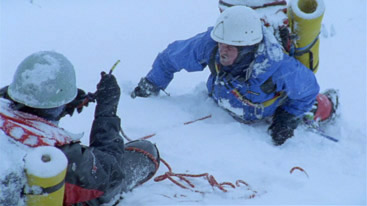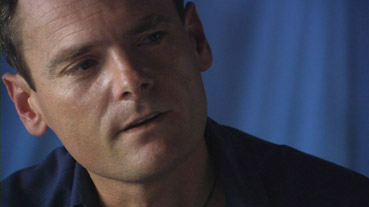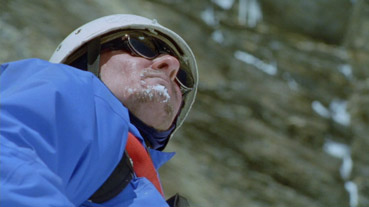|
Since
the considerable commercial success of Michael Moore's Bowling
for Columbine, the documentary feature
is undergoing a welcome renaissance, and is not just giving
the fiction-based brother a run for its money but dramatically beating
it at its own game. Bowling Columbine had the political bite American features have lacked since
the late 70s, Être et Avoir managed
to present children in a moving and involving way without
a hint of Hollywood mawkishness, and Rivers
and Tides succeeded in getting closer
to an artist and to communicating what drives them than any based-on-fact
drama. And now we have Touching the Void,
a study of survival against insane odds that is more gripping and
more thrilling than any fictional feature I've watched so far this year.
Truth, as is often claimed, may not actually be stranger
than fiction – how could it be? – but on the evidence of this extraordinary
movie, it's a whole lot more exciting.
In
May 1985, young British climbers Joe Simpson and Simon Yates
chose to scale a treacherous unclimbed
face of the Siula Grande mountain in the Peruvian Andes.
Others had tried but had always been defeated by the sheer
difficulty of the climb and the sometimes treacherous conditions,
but the enthusiasm and youth of the two men convinced them that
they would succeed where others had failed. They elected
to climb the mountain 'Alpine style', tethered to each other
and carrying only enough food and equipment for a single
shot at the summit, and with the weather initially on their
side, they made phenomenally good progress. Even when the
clouds built up and the wind and snow slowed them down to
a crawl, they took shelter and battled on, and despite some
intimidating snow formations on the mountain's ridge, they
made it to the top. It was on the way down that the problems
began. The weather moved in again and they became lost,
then Yates nearly fell. But they were a good way down the
mountain when disaster struck, and Simpson slipped and broke his
leg. As high as they still were and with the weather so
poor, this meant only one thing – Yates would have to go
on and leave Simpson to die alone on the mountain. But
Yates did not leave him, instead devising a way of lowering his companion three-hundred feet at a time using two ropes knotted together. Despite
the excruciating pain this put Simpson through, it appeared
to be working, at least until Simpson slipped over a ledge
and was left dangling in mid air, too weak and injured to
pull himself up or communicate with Yates, who was dug into
the snow, unable to lower the rope further and being slowly
pulled towards the ledge and his own probable death. Believing Simpson to be dead, he eventually took the decision to cut the rope, sending his companion plumetting through air and ice until he came to rest on a ledge at the top of a deep crevice. What happened
next was to become part of mountaineering legend.

To
suggest that mountaineers are a different breed to the rest
of us is somewhat simplistic, but as someone whose stomach
goes into knots if I get above the third floor of a building,
the appeal of clambering up the side of a sheer rock or
ice face with nothing below but plummeting death has
curiously edluded me. But I love mountains – I
think they are among the most beautiful and awe-inspiring
objects to be found anywhere in nature, and I have a
genuine admiration for those who do choose to scale them.
Hell, if I wasn't so terrified of heights, was younger and
fitter and had the same sense of driven adventure, I'd certainly
think about doing it too.
Mountaineering
stories have a fascination for me, in part because they often
seem to involve individuals triumphing against impossible
odds for no other reason than the thrill of doing it. But
even within the ranks of great mountaineering survival stories,
this one stands high. The above plot synopsis merely sets
the scene – things get far, far worse before they get better.
It is Simpson's struggle to survive, to get out of a seemingly
impossible situation (and since he is the first person interviewed
in the film, as well as the writer of the book on which
the film is based, we know he does survive) that gives
the film its meat, shape its narrative, and make it such a compelling cinematic experience.
The
structure is deceptively simple: interviews with the three
main protagonists – Simpson, Yates and Richard Hawking,
a non-climber who joined their team after meeting them en
route and who stayed at base camp for the duration of the
climb – are alternated with reconstructions of the climb itself
and subsequent descent. And that's it. So just what is it
that makes it so extraordinary?
First
up is the story itself. As anyone who has read Simpson's
riveting book will tell you, this is one hell of a tale.
Even told by a friend over a pint at the pub it would have
you slack-jawed in astonishment, but related by those involved
it is something else – all three interviewees here are engaging
and hugely likeable, and are both honest and direct in the
telling of their stories. Simpson in particular paints a
most vivid picture of the suffering he went through – his
description of what happened to the bones in his leg when
it broke had the entire cinema audience on my first
viewing sucking air through clenched teeth in
horror in a way that no staged version could prompt (the
film's own recreation of the event is nicely matter-of-fact
and doesn't even try to compete).

And
then there are the reconstructions. Now I, for one, was
more than a little cynical about this element, as reconstructions
in documentaries are too often flatly performed and directed,
but right from the early big close-ups of pitons being driven into ice and wider shots of the climbers dwarfed
by their surroundings there is a stamp of documentary authenticity
on these sequences. This is enhanced further by unfussy
performances by Brendan Mackey and Nicholas Aaron as Simpson and Yates respectively – even in the most emotionally
charged moment, when Simpson, lying trapped in a crevice
with no hope of escape screams obscenities into the blackness,
the performance never feels 'acted'. More often than not
they are there to visualise the description of the commentators,
but even at this level the film-making is arresting and often genuinely inspired – the climbers' description of snow formations on the peak is intriguing,
but actually seeing them is breathtaking. As the film progresses,
these scenes become less observational and less illustrative,
and more about connecting emotionally with Simpson's deteriorating
mental state. Exhausted, chronically dehydrated, in constant
pain and convinced he was going to die, it is
genuinely impossible to really imagine what Simpson went
through, but director Kevin Macdonald (who won an Oscar
in 2000 for his electrifying account of the 1992 Munich
hostage incident, One Day in September) comes closer to visualising the experience
than you'd expect from a docudrama, most vividly in his
use of the snorricam so beloved of Darren Aronovsky, where
the camera is connected directly to the actor so that it
moves with him and feels locked in to his emotional state.
The
photography is often breathtaking but never superficially
so, and is instead used to most effectively create a sense
of the sheer scale of the landscape and the task facing
the two climbers, and later the seemingly impossible nature
of Simpson's predicament. This is emphasised by the sound
design, whether it be the crunch of snow beneath the climbers'
feet, the genuinely heart-stopping noise of cracking ice
when Simpson is crawling across it in pursuit of an escape
route, or the infuriating running water that the desperately
thirsty climber can hear but not reach.
Touching
the Void wipes the floor with idiotic, overblown Hollywood fare like Cliffhanger and Vertical Limit and from a mountainous height.
This is the genuine article, a real climber in a genine life-or-death situation, and an astonishing story of
man's ability to survive against all odds. Abandon any negative
preconceptions you may have of the documentary genre formed
by too many nights watching The History Channel – Touching
the Void is more thrilling, more awe-inspiring,
more genuinely, heart-clenchingly gripping than any fiction
film I have seen all year.
Framed
at 1.78:1 and anamorphically enhanced, this is a first-rate
transfer typical of VCI at its best. Sunlight snowscapes
in particular really shine, with excellent contrast and bright,
solid colour rendition – there is visible grain on some night
scenes, but this was just as evident in the cinema.

As
if beating fictional features at their own game in terms of
emotional involvement wasn't enough, the film has a 5.1 soundtrack
that, though not overly showy in the way of Hollywood features,
blows almost everything else I've heard this year out of the
water just for its subtle effectiveness. Wind howls around
the room, ice falls from on high and clatters to the ground
behind your head, deep rumbles that seem to emanate from the
mountains themselves rattle the bass. The sense of place is
vividly evoked and the mix manages also to create a sense
of both the majesty and the danger of the location, never
more so than in the aforementioned scene in which Simpson
has to cross an ice platform to reach a potential safety route
and the sounds of cracking ice shoot around the room alarmingly,
really adding to the already cranked-up tension of this scene.
Some have complained that much of the sound (at least
on the region 1 disc) is front weighted, but since the soundtrack
consists mainly of interview material, where did they seriously
expect it to come from? The 5.1 is used to its best – not
flashiest – effect at all times, never more so than in the
film's most memorable moment, when the Simpson's whole consciousness,
and the entire soundstage, is overwhelemed by Boney M singing Brown Girl in the Ring (you need to see the film
to understand why).
Though
there are just three extras on this disk, all are not just
worthwhile, but good enough to buy the disk for even if you
caught the film at the cinema.
If
the concept of a 'making of' documentary for a documentary
feature seems a little odd, then go check out the excellent one
on the Dark Days disk – the story of the
film's making is almost as extraordinary as the feature itself.
Though shorter than that particular extra and slimmer on revelatory
detail, Return to Siula Grande is
still a fascinating and informative piece in its own right. Shot and directed
by MacDonald, it includes footage of the shoot itself and
a few genuine surprises, the biggest being that Simpson and Yates actually played themselves in some of the
reconstruction sequences. But the key inclusion has to be
extracts from Simpson's own video diary, which he kept during
the shoot. Right from the start he has severe reservations
about returning to the Siula Grande, all too aware of the
memories it will re-awaken, and as the film progresses these
talks to camera make for increasingly uncomfortable viewing,
as we are forced to think long and
hard about what Simpson had to go through for our entertainment.
Close to the end, MacDonald interviews Simpson and asks him
how he feels about returning to this location, and he replies
with a barely controlled mixture of anger and contempt: "Do
you have any idea how bad it was? I don't think you do. I
don't think you have the first idea. I died here!"
An essential extra, this is presented in non-anamorphic 16:9
with Dolby 2.0 sound, and runs for 25 minutes.
What
Happened Next is anamorphic 16:9 and runs for close to 10 minutes, and consists
of more interview footage with the three main protagonists.
The title tells all here – the interviews detail what happened
after the three had left the mountain, and include some pretty
extraordinary information, especially regarding Simpson's
lack of medical treatment at the hospital they eventually
reach. This works as a nicely effective postscript to the
film itself.
Finally
there is the Trailer, which is anamorphic
16:9 and has – and this is a rare thing for a trailer – a
5.1 soundtrack. As usual for a documentary trailer, it's
cut like it's for a thriller (which, to an extent, it is), but is very
nicely done, and the use of sound and graphics is particularly
effective.
After
some years consigned to TV screenings on specialist satellite channels,
the documentary feature is back where it belongs, in the cinema,
and partly as a result is getting decent DVD releases. Touching
the Void is not just an excellent example of the genre,
it manages to beat most recent fictional thrillers at their
own game. This is compelling, thrilling cinema, and if it inevitably
loses something of its extraordinary scale on the smaller screen
(it should be noted that when we screened this in the cinema
it played to a full house), it still looks and (especially)
sounds great on DVD, boasts a couple of first-rate extras and,
most importantly, remains one of the year's genuinely exciting
and beautifully realised films.
|